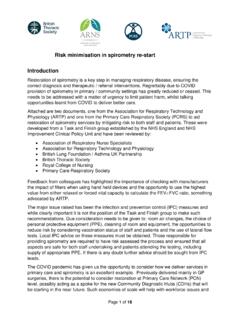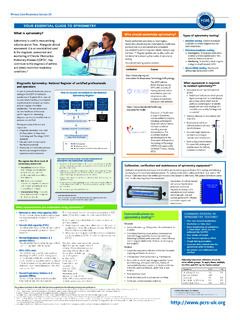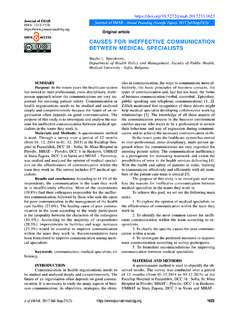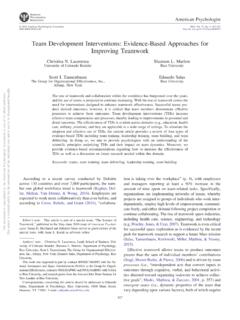Transcription of Teamworking in the NHS a policy perspective
1 Teamworking in the NHS a policy perspective Bronwen Thompson, policy adviser to PCRS-UK November 2013, RL workshop, Hinckley teamwork is about shared leadership Integrated care relies on teamwork teamwork is a requirement for patients The patient (and carer) need to be part of the team providing care for them Overview Overlapping themes 3 Integrated care Leadership Patient centred care Teamworking teamwork = shared leadership teamwork depends on a range of factors, but is not about abandoning leadership Work in Canada highlighted some key factors underpinning successful teamwork Leadership, and having champions who can drive change management processes Clarity regarding roles on the part of all team members Trust, respect, value, and being valued within the teamwork setting Cultural readiness within the workplace, or significant efforts to try to create a culture of acceptance 4 HealthcarePapers, 7(Sp) January 2007: Invited Essays Effective teamwork in Healthcare.
2 Research and Reality Dave Clements, Myl ne Dault and Alicia Priest Teams without walls Key features of successful integrated working identified by the report are: Clinical leadership and involvement High-quality partnership between clinician and professional manager Primary and secondary partnerships Committed commissioners willing to innovate and fund flexibly Clear patient focus for a defined group Clear governance arrangements Agreed measures and standards to improve the quality and quantity of work. 5 Teams without walls 6 Elements that hinder integration are: Clear separation of managerial and clinical aims No clinical leadership Targets with unintended negative consequences A culture of competition rather than collaboration Financial flows that encourage efficiency without considering effectiveness A 'command and control' ethos that does not value learning.
3 7 Integrated care relies on teamwork 8 GP Practice nurse Integrated care relies on teamwork 9 GP Practice nurse GP GP GP Practice nurse Practice nurse GP trainee GP trainee Referral coordinator Referral coordinator Pharmacist Home health nurse Therapists Practice manager Evaluation of 16 x 2 year integrated care pilots Staff more positive than patients 63% found job more interesting 60% working more closely with other organisations 72% reported better communication with other organisations But Patients did not in general report improved care 15% fewer patients felt their opinions an preferences were taken into account 5% fewer patients felt involved by Drs in decisions about care 9% fewer patients felt able to see nurse of choice Concluded that no single approach suits all, change may take longer than expected, need strong leadership scaled to match local capacity 10 14 new integrated care pioneer sites announced in November 2013 11 A new centralised monitoring centre has been set up.
4 When the centre is alerted about an emergency case, it is assessed within one of three categories (individual, families, and communities) and the right kind of help is delivered. This will help ensure that the right help is dispatched quickly to the relevant patient. (Barnsley) Fifteen organisations from across health and social care, including local councils, charities, This is about relieving pressures on the system and making sure patients are treated in the right place. Teams will come together to prevent people from falling through the gaps between organisations. (Cornwall and Isles of Scilly) Teams of nurses, social workers, occupational therapists and physiotherapists work together to provide a multidisciplinary response to emergencies arising within the community which require a response within 24 hours.
5 The team responds to emergencies they are alerted to within the community at care homes, A&E and through GP surgeries, and handle those which could be dealt with through treatment at home or through short term residential care. (Greenwich) Twelve health and social care teams now work in Leeds to coordinate the care for older people and those with long-term conditions. The NHS and local authority have opened a new joint recovery centre offering rehabilitative care to prevent hospital admission, facilitate earlier discharge and promote independence. In its first month of operation, it saw a 50% reduction in length of stay at hospital. (Leeds) teamwork is a requirement for patients Web of care for breast cancer patient 12 Integrated care vs coordinated care Work done by National Voices People want co-ordination.
6 Not necessarily (organisational) integration People want care. Where it comes from is secondary They want the system to deliver two things to them: of the patient as a person including home circumstances, lifestyle, views and preferences of the relevant condition(s) and options to treat, manage and minimise them including knowledge of all available support services 13 National voices What do patients, service users and carers want? 2012 What coordinated care means to patients no big gaps between seeing the doctor, going for tests and getting the results being kept informed about next steps being signposted to relevant sources of advice (including local and national support organisations) professionals working together as a team around them having a single point of contact who can answer questions and help pull everything together having access to their health and care records, being able to correct them and share them as they wish receiving comprehensive and timely information being as involved, along with their carer, in discussions and decisions about their care and treatment as they want to be developing a care plan with their main professional contact and knowing who to contact if things change having these care plans clearly entered on their record and respected by each service used.
7 14 National voices Coordinated care Benefits of Teamworking for healthcare professionals Safety, reducing medical errors, improving quality of patient care, addressing workload issues, building cohesion and reducing burnout of healthcare professionals (Oandasan 2006) Improved communication and partnership among health providers and patients (Kates and Ackerman 2002; Nolte 2005) Clarity on the role of all health providers (Nolte 2005) Better response processes in addressing the determinants of health (Nolte 2005) Improved coordination of healthcare services (Kates and Ackerman 2002) High levels of satisfaction on the delivery of services (Kates and Ackerman 2002; Marriott and Mable 2002) Effective use of health resources (Task Force Two 2005) 15 HealthcarePapers, 7(Sp) January 2007: Effective teamwork in Healthcare: Research and Reality Dave Clements, Myl ne Dault and Alicia Priest Benefits of Teamworking for healthcare professionals Safety, reducing medical errors, improving quality of patient care, addressing workload issues, building cohesion and reducing burnout of healthcare professionals (Oandasan 2006) Improved communication and partnership among health providers and patients (Kates and Ackerman 2002; Nolte 2005) Clarity on the role of all health providers (Nolte 2005) Improved coordination of healthcare services (Kates and Ackerman 2002) High levels of satisfaction on the delivery of services (Kates and Ackerman 2002.)
8 Marriott and Mable 2002) Effective use of health resources (Task Force Two 2005) 16 HealthcarePapers, 7(Sp) January 2007: Effective teamwork in Healthcare: Research and Reality Dave Clements, Myl ne Dault and Alicia Priest teamwork is seen as a way to improve quality of care for the patient, not only through improved efficiency but also through a happier and healthier workforce. Different and distinct roles 17 Different perspectives 18 A never event .. 19 The patient must be part of the team 20 What we need in health is a very, very, very big change in the relationship between people who get ill (which is all of us at some point) and the people who are meant to make them better when they do. At the moment, the relationship is a bit like a bad one between a parent and a child. The child is the kind of child who eats what he likes, and drinks what he likes, and sometimes nicks a bottle from the back of a kitchen cupboard, and sometimes nicks a fag.
9 The parent is one who also eats what he likes, also likes a fag, and who doesn t do any exercise, and is a bit tired and cross. The parent will see the child if he has to. He ll make an appointment (at a time that suits him and not the child) and then pass him on to somebody else. Christina Patterson, writer and columnist at the Independent FROM 21 What we will expect in this partnership is a relationship that works both ways. We will expect to do more to keep ourselves well. We will expect the health service to provide better systems to help us when we re not. We will, for example, expect phone calls and emails to be answered, and appointments to be fixed in good time, and files, and X-rays, and blood test results (which will now be stored, with our records, in a health cloud we can access) not to be lost.
10 We will expect to be treated like an adult, and spoken to like an adult, and we will not expect anyone to treat us as if their time was more precious than ours. Christina Patterson, writer and columnist at the Independent TO The patient must be part of the team 22 Patients want professionals working together as a team around them teamwork is about shared leadership Integrated care relies on teamwork teamwork is a requirement for patients The patient (and carer) need to be part of a team providing care for them In conclusion teamwork is about shared leadership In conclusion Integration of care in itself is not a technical or a policy challenge, it is much more of a leadership challenge. Leaders must then work together to nurture healthy, positive cultures and that will require them to embrace the concept of collective leadership.












